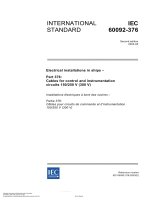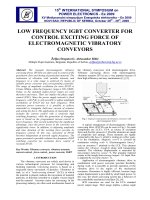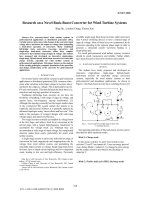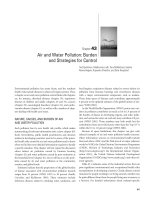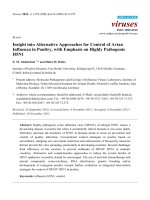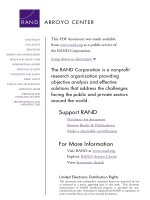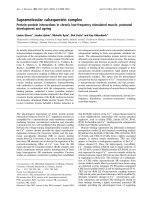LOW FREQUENCY IGBT CONVERTER FOR CONTROL EXCITING FORCE OF ELECTROMAGNETIC VIBRATORY CONVEYORS
Bạn đang xem bản rút gọn của tài liệu. Xem và tải ngay bản đầy đủ của tài liệu tại đây (367.91 KB, 5 trang )
15
th
INTERNATIONAL SYMPOSIUM on
POWER ELECTRONICS - Ee 2009
XV Međunarodni simpozijum Energetska elektronika – Ee 2009
NOVI SAD, REPUBLIC OF SERBIA, October 28
th
- 30
th
, 2009
LOW FREQUENCY IGBT CONVERTER FOR
CONTROL EXCITING FORCE OF
ELECTROMAGNETIC VIBRATORY
CONVEYORS
Željko Despotović, Aleksandar Ribić
Mihajlo Pupin Institute, Belgrade, Republic of Serbia
,
Abstract: The resonant electromagnetic vibratory
conveying drives (EVCD) are often used to control of the
gravimetric flow and dosing of particulate material. The
realization of vibration with variable intensity and
frequency in a wide range is achieved by means of
suitable power converter and corresponding controller.
The range of amplitude oscillation for most EVCD is
0.1mm-100mm, while the frequency range is 1Hz-100Hz.
Today, as the standard output power stages are used
thyristors and triacs. Their use implies the phase angle
control (PAC). Since the power supply network is fixed
frequency, with PAC is only possible to adjust amplitude
oscillations of EVCD but not their frequency. With
transistor power converter it is possible to achieve
sinusoidal or triangular half-wave current of actuator
and setting his force. The application of sinusoidal wave
includes the current control with a relatively high
switching frequency, while the generation of triangular
wave is based on the programmed current control at
lower frequency. This second method has the significant
advantage, since the power losses in the converter are
significantly lower. In addition, to adjusting amplitude
and time duration of the exciting force provide its
frequency control. In this way, operation of EVCD
becomes independent of network supply frequency. The
paper presented a possible solution low-frequency IGBT
switching converter for excitation force control of
resonant EVCD.
Key Words: Vibratory conveyor, vibratory actuator,
current control, force control, power converte, IGBT
1. INTRODUCTION
The vibratory conveyors are widely used device in
various technological processes for transporting and
finishing materials. Conveying process is based on a
sequential throw movement of particles. Vibrations of
tank, i.e. of a “load-carrying element” (LCE), in which
the material is placed, induces the movement of material
particles, so that they resemble to a highly viscous liquid
and the material becomes easier for conveying. In the
processing industry are often used mechanisms based on
the vibratory conveyors with electromagnetic drive.
Vibratory conveying drives with electromagnetic
vibratory actuator (EVA) are a very popular because of
their high efficiency and easy maintenance [1], [2].
Fig.1. Typical construction of vibratory conveyer with
electromagnetic drive
A typical arrangement of electromagnetic vibratory
conveying drive (EVCD) can be seen in Fig.1. Its main
components are LCE-1, EVA as source of excitation
force and flexible elements-2. Flexible elements are made
of composite leaf springs. These elements are rigidly
connected to the base-3, which is resting on rubber pads-
4 to the foundation. Magnetic core-5 is covered by
continuous winding coils- 6. Electromagnetic force
acts on armature-7 attached to the LCE. This element
carries the vibratory trough-8 along with transporting
material. The vibratory displacement is measured by
non-contact inductive sensor- 9. The granular material
comes to the trough from storage hopper- 10. Input flow
is adjusted by movable shutter- 11.
f
Application of electromagnetic vibratory drive in
combination with power converter provides flexibility
during work. It is possible to provide operation of the
vibratory drive in the region of the mechanical
resonance. Resonance is highly efficient, because large
output displacement is provided by small input power. In
this way, the whole conveying system has a behavior of
the controllable mechanical oscillator [3], [4].
SCR converters are used for the EVA standard
power output stage. Their usage implies a phase angle
control [4-6]. Firing angle varying provides the
controlled AC or DC injection current of EVA or
controls his mechanical force. This force is squared
function of current in EVA winding coils [3], [5-7].
One type of this converter-unidirectional, with DC
pulsing output current, using only one half period of
mains voltage. They are implemented with a one
thyristor as shown in Fig.2 (a). In this case thyristor
firing is achieved only in positive half wave as shown in
Fig.3 (a). The output voltage (50Hz or 60Hz) is
converted to pulsating DC current of EVA i.e. pulsating
force of EVCD. In this way, generate vibrations of
discrete spectrum like in Fig.3, depending on the
moment of thyristor firing.
Fig.2. Power converter with phase angle control for
vibratory conveying control; (a)-unidirectional, (b)-
bidirectional
Another type power converter- bidirectional with
AC output current, using full period of mains voltage.
They are implemented with triacs or ant-parallel
connection of thyristor for higher power application, as
shown in Fig.2 (b).With these power converters is the
mains frequency 50Hz/60Hz converted to AC power
supplied to the same frequency coil EVA as shown in
Fig.3(b).
Fig.3. PAC for vibratory conveying drive; EVA voltage and
current; (a)-bidirectional mode, (b)-unidirectional mode
Today is intensively working on implemented of
high-frequency (HF) power converters for obtaining
sinusoidal current in the EVA. As in the case of SCR can
talk about on unidirectional and bidirectional converter
type, depending on whether there was DC pulsating or
AC excitation of EVA. The generally accepted
topologies are shown in Fig.4.
Fig.4. Power converter switching topology for driving EVA;
(a)- asymmetrical half bridge,(b)-symmetrical half bridge, (c)-
full bridge
The HF switching converters, despite significant
merits, have a shortcoming of having switching losses
which become dominant at high frequencies. This
reduces the efficiency of the EVCD and power losses in
the converter are often higher than the power required for
maintaining the resonant oscillatory regime. This reduces
considerably the efficiency of the whole system [9].
By suitable way to control of EVCD it is possible
to overcome this problem. In the present paper this is
obtained by generating low frequency triangle current
pulses of EVA. One possibility is to use half-bridge like
in Fig.4 (a).
2. MODELLING OF EVCD DYNAMICS
Principle of amplitude-frequency control means
actuating force is given on the block diagram in Fig.5. A
high performance exciting force control of EVCD
requires a detailed analysis of their electromagnetic and
mechanical part.
Fig.5. Principal block diagram of regulated EVCD
2.1-Electromagnetic part
Detailed electrical model of EVA is derived in [5]. It
can be written as [10-13]:
()
()
di L y dy
Ly R i u
dt y dt
⎛
∂
⎞
+ +=
⎜
∂
⎝⎠
⎟
(1)
2
1()
2
L y
f i
y
∂
=
∂
(2)
where, and
R
()L y
denotes EVA coil electrical
resistance and inductivity, and , , denotes LCE
position in relation to conveyer base, EVA coil current
and EVA coil voltage respectively. Mechanical force
y i
u
f
is produced by the electromagnet. According to Fig.5,
EVA coil voltage depends on control voltage
u
D
u
:
,1
,0
0, 0 0
sD
sD
D
Vu i
uVu i
ui
=∧Δ>
⎧
⎪
0
0
= −=∧Δ<
⎨
⎪
=∧=
⎩
(3)
where
s
V
is source voltage. As will be shown later,
pulses are always triggered around equilibrium
position
0
yy=
, so could be approximated
L(y)
with
0
00
() ( ) /
yy
Ly L y y L y
=
≈+− ⋅∂∂
. Now, equation (1) can be
approximated around as:
0
yy
=
0
0
','
yy
di dy L
LRiuRR
dt dt y
=
∂
+= =+
∂
(4)
where parameter , dependant on velocity dy/dt ,
represents equivalent resistance. Pulses generated by
control logic are short, so supposing that the equivalent
time constant
R'
0
/'L R
is much greater then pulse
duration, we obtain . Now, we can neglect term
'Ri u<<
'R i
in (4), so final approximation of (1) is given by:
0
di u
dt L
=
(5)
2.2 Mechanical part
Detailed mechanical dynamics model of EVCD is
given in [10-14] and has the following
form:
MzCzKz f++=Γ
&& &
(6)
Vector
4
z R∈
represents state vector containing
positions and angles of respective parts, and M, C, and K
are symmetric matrices. Vector defines acting of
force
Γ
f
onto the corresponding parts [4-6], [10], [15].
The equation (5) implies four oscillation modes of the
given system, but not all of them are interesting for
analysis. Particularly, all machines are mechanically
constructed in the manner that undesirable modes are
highly damped and/or excited in the smallest possible
measure. This fact leads to conclusion that model of the
mechanical part of EVCD can be approximated with
only one dominant oscillating mode [4-6], [11-13 ], [15]
:
22
00 0 0
2()
p
yyyyK
ςω ω ω
+⋅+⋅−=⋅⋅
&& &
f
(7)
where
o
ω
(rad/s),
ς
and denotes resonant
frequency, damping factor, and static gain respectively.
p
K
3. CURRENT CONTROL of EVA
The simple pulse width control, applying to the
topology in Fig. 4(a), provides easy and simple control of
EVA coil current. Control circuit wheel that provides the
amplitude, duration and frequency adjust of triangle
current half-wave is shown in Fig.6. With the appropriate
sensors is measured the value of the EVA current – .
Measured signal is amplified with
()it
i
K
value and thus
enhanced signal is introduced into the adder where it is
compared with the reference value of amplitude
current
Mref
I
. Setting of RS flip-flop (FF) is realized
from the impulse voltage controlled oscillator (VCO).
This oscillator determines the frequency i.e. the period
of triangle half- wave current.
d
T
Bringing the signal from the VCO on the set input of
the FF establishes the state of logical "1" at its output .
In this case switches Q1 and Q2 are in the state “ON”.
This establishes a current through the EVA coil in rising
ramp as a positive voltage
Q
s
V+
is applied to the EVA
coil, as shown in Fig.6 (b). This increase is realized until
the moment when the actual value of the current-
reaches a reference value of amplitude , when the
reset pulse is generated at the input R to the FF.
()it
Mref
I
After that comes to establishing state logical "0" on
its Q output. In this case switches Q1 and Q2 are in the
state “OFF”, while the EVA coil current takes free-
wheeling diode D1 and D2. Accordingly it is obtained a
linear decrease of EVA coil current, since the negative
voltage applied to it. This reset state is retained
until the appearance of a new set impulse from the VCO.
-Vs
Fig.6.Programming current control for adjusting
amplitude, duration and frequency of EVA coil current; (a)-
principal sheme , (b)-characteristics waveforms
The amplitude and time duration of EVA coil
current are determined by control voltage , which
actually represents the value of
p
V
Mref
I
. The frequency of
current pulses i.e. excitation force pulses is determined
by control voltage .
f
V
Since the reactive resistance of the EVA coil is
dominant (much higher than the active resistance) can
write the approximately relation for rising time
r
τ
of
EVA current:
0 Mref
rf
s
LI
V
ττ
⋅
≈=
(8)
and relation for total duration of the EVA current :
0
2
Mref
s
LI
V
τ
⋅ ⋅
≈
(9)
From these relations it follows important conclusion that
the duration of the current half-wave is linear function of
.
Mref
I
4. SIMULATION RESULTS
The characteristic waveforms in the case of the
previosly described current control are given in this
section.The influence of current reference changes and
control logic signals at the entrance to the FF on the
EVA current and output displacement are given in Fig.7.
Fig.7. The influence of refrence current change on the
output displacement of EVCD; (a)-output displacement and
EVA current, (b)-detail of interval I , (c)-detail of interval II
In the simulation is set to the value of the resonant
frequency of the mechanical system and period
of driving pulses ( ).
rez
f =52Hz
d
T=19.3ms
pob
f=52Hz
The simulations records of vibratory trough
displacement- and EVA current- in the case of
changing amplitude current reference are given on Fig.7
(a). On the simulation records are marked two intervals
of interest.
()yt ()it
These intervals are presented in detailed together
with the corresponding control signals SET and RESET.
The interval-I is given on the Fig.7 (a), while the
interval-II is given on the Fig.7(c). In the first moment is
established stationary regime with amplitude
displacement value of i.e. vibratory width
value of in which the amplitude of EVA
current was .In the moment of time is
setting sudden increase of reference value of current
half-wave forms around 40%. As a result, there has been
an increase in amplitude of the output displacement on
the value i.e. vibratory width value
of . In addition to the current amplitude
changes has been a change of time increase the value of
EVA current from value to
value .These values actually represent the
time interval between corresponding pulses
SET
and
RESET
of FF, as shown in Fig.7(b),(c).
m1
Y =0.1mm
(p-p)1
Y=0.2mm
m1
I =280mA
t=2.5s
m2
Y =0.2mm
(p-p)1
Y=0.4mm
r1
τ =0.64ms
r1
τ =1.70ms
5. EXPERIMENTAL RESULTS
The experimental results are obtained on real realized
laboratory prototype of resonant EVCD at which the
applied current control and high performance exciting
force control. The principle scheme of the realized
system with IGBT power converter is given in Fig.10.
Detailed description of this IGBT converter is given in
[3]. It is experimentally observed the values of interest:
EVA current- i(t) and output displacement of vibratory trough –
y(t).
On the oscilloscopic records in Fig.8. are shown the
impact of changes in the duration of current pulse on the
output displacement of vibratory trough at the resonant
frequency and unchanged amplitude
current .
At the stationary and unchanged
resonance regime, change of current pulse duration for
about 33%, caused a nearly twofold greater change in the
value of the amplitude oscillation of the vibratory trough.
rez
f =45.5Hz
Mref
I=0.5A
On the Fig.9 are shown the load change
compensation of EVCD and oscilloscopic records of
characteristic values (EVA current, EVA voltage and
displacement of vibratory trough).
Fig.8.
The influence of change EVA current duration on the
output displacement
;(a)-EVA current duration τ=3ms,(b)- EVA
current duration τ=4ms; CH1- EVA current (0.2A/c),CH2-
displacement (1mm/c).
Fig.9. The load mass compensation of EVCD through
changing frequency of EVA current,
(a)-excitation frequency
(b)- excitation frequency ;
CH1-EVA current (0.5A/c),CH2- displacement (2mm/c), CH3-EVA
voltage (200V/c).
p1 rez1
f =f =50Hz
p2 rez2
f=f =41.5Hz
The mass change was achieved with from
to value . Oscilloscopic
records for mass load (empty vibratory trough) are
shown on Fig.9 (a). Oscilloscopic records for mass load
are shown on Fig.9 (b). The load change
compensation and maintaining constant vibration
amplitude of vibratory trough is achieved by changing
the frequency of EVA current (from
to ) at same value of time
duration .
k0
m =1.15kg
1
1.65
k
m= kg
0k
m
1
k
m
rez1
f=50Hz
rez2
f=41.5Hz
τ=4ms
Fig.10. Principal diagram of implemented IGBT converter for current control of EVCD
The mass change was achieved with from
to value . Oscilloscopic records for mass
load (empty vibratory trough) are shown on Fig.9
(a). Oscilloscopic records for mass load are shown
on Fig.9 (b). The load change compensation and
maintaining constant vibration amplitude of vibratory
trough is achieved by changing the frequency of EVA
current (from to ) at same value
of time duration .
k0
m =1.15kg
1
1.65
k
mk= g
0
k
m
1
k
m
rez1
f=50Hz
rez2
f=41.5Hz
τ=4ms
6. CONCLUSION
The paper presented a possible solution to excitation
force control of EVCD. Presented simulation and
experimental results showed that current control of EVA
is a very effective way to amplitude and frequency
control of resonant EVCD. Resonant regime is very
important from the aspect of minimizing energy
consumption of the entire EVCD.
The current control is achieved such that a
mechanical system is controllable mechanical oscillator,
independent of the supply network frequency, which was
achieved a significant improvement compared to the
thyristors and triacs drives.
7. REFERENCES
[1] H.G.Cock ,“Vibratory Feeders“-PHILIPS Technical
Review, Vol.24, May 1975,pp.84-95.
[2] P.U.Frei, “An Intelligent Vibratory Conveyor for the
Individual Object Transportation in Two Dimensions”,
Proceedings of the 2002 IEEE/RSJ, Intl. Conference on
Intelligent Robots and Systems,
EPFL, Lausanne,
Switzerland
,
October 2002, pp.1832-1837.
[3]
Z.Despotovic and Z.Stojiljkovic,
”Power Converter
Control Circuits for Two-Mass Vibratory Conveying System
with Electromagnetic Drive: Simulations and Experimental
Results”
, IEEE Transaction on Industrial Electronics,
Vol.54, Issue I, Februar 2007,pp.453-466.
[4]
T.Doi, K.Yoshida, Y.Tamai, K.Kono, K.Naito, T.Ono,
“Modeling and Feedback Control for Vibratory Feeder
of Electromagnetic Type”, Journal of Robotics and
Mechatronics , Vol.11, No.5, June 1999, pp. 563-572.
[5] N.Barjamović,“Tiristori u sistemima za doziranje rasutih
materijala”, II simpozijum Energetska elektronika – Ee
’75, Beograd (YU), Oktobar 1975, pp.334-348.
[6]
T
.
Doi, K.Yoshida, Y.Tamai, K.Kono, K.Naito, T.Ono,
“Feedback Control for Electromagnetic Vibration
Feeder”, JSME International Journal, Series C, Vol.44,
No.1, 2001, pp. 44-52.
[7] Ž.Despotović, M.Jovanović, Z.Stojiljković, “Tiristorski
pretvarač za pogon elektromagnetnih vibratora”, X
simpozijum Energetska elektronika – Ee ’99, N.Sad
(YU), Oktobar 1999, pp.150-156.
[8]
Z
.
Despotovic, Z. and Z. Stojiljkovic, ”PSPICE
Simulation of Two Mass Vibratory Conveying System
with Electromagnetic Drive” , PROCEEDINGS of
International Conference EUROCON 2009-“Computer
as a tool” , Belgrade 21.XI 24.XI.2005, Vol. II,
pp.1509-1512.
[9] Z.Despotovic, Z.Stojiljkovic,
“A Realization AC/DC
Transistor Power Converter for Driving Electromagnetic
Vibratory Conveyors”
,
PROCEEDINGS of the V
Symposium of Industrial Electronics-INDEL, Banja
Luka, 11-13.IX.2004, Vol. T2A, pp.34-40.
[10] V.Gourishankar, D.H.Kelly, “Electromehanical energy
conversion”, Billing and Sons Ltd., Guldford &
London, London, 1973.
[11] Z.Despotovic,“Mathematical model of electromagnetic
vibratory actuator”, PROCEEDINGS of the XII
International Symposium of the Power Electronics,
N.Sad 5.XI-7.XI.2003, Vol.T3-3.2, pp.1-5(In Serbian).
[12] S.Seely, Electromechanical energy conversion”,
McGraw-HILL Book Company INC., New York, 1962.
[13] Z.Despotovic, M.Pesko, “Mathematical Model of
Vibratory Feeder Drive with Electromagnetic Vibratory
Actuator”, PROCEEDINGS of the XLVIII Conference
ETRAN, Cacak, 8-13.06.2004, Vol.I, pp.276-279.
[14] P.Wolfsteiner, F.Pfeiffer, “Dynamics of a vibratory
feeder”, PROCEEDINGS of DETC '97, ASME Design
Engineering Technical Conferences, Sacramento,
California, DETC97/VIB-3905,Sept.14-17,1997, pp.1-9.
[15] T.Doi, K.Yoshida, Y.Tamai, K.Kono, K.Naito,T. Ono
“Feedback Control for Vibratory Feeder of
Electromagnetic Type”, Proc. ICAM’98, 1998, pp. 849-
854.


